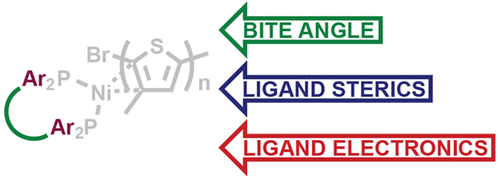当前位置:
X-MOL 学术
›
Macromolecules
›
论文详情
Our official English website, www.x-mol.net, welcomes your feedback! (Note: you will need to create a separate account there.)
Elucidating the Role of Catalyst Steric and Electronic Effects in Controlling the Synthesis of π-Conjugated Polymers
Macromolecules ( IF 5.5 ) Pub Date : 2020-01-03 , DOI: 10.1021/acs.macromol.9b02098 Adam A. Pollit 1 , Shuyang Ye 1 , Dwight S. Seferos 1, 2
Macromolecules ( IF 5.5 ) Pub Date : 2020-01-03 , DOI: 10.1021/acs.macromol.9b02098 Adam A. Pollit 1 , Shuyang Ye 1 , Dwight S. Seferos 1, 2
Affiliation

|
Kumada catalyst transfer polymerization (KCTP) has been widely adopted to synthesize π-conjugated polymers for various electronic and biological applications. However, the scope of monomers that can be polymerized with control is generally limited to small electron-rich (hetero)cycles. Because control over polymer molecular weight, dispersity, and end-groups is intrinsically linked to intramolecular catalyst transfer, improved catalysts are necessary to broaden the scope of this important polymerization technique. In this study, we present a computational investigation of how ligand bite angle, steric substituent effects, and electronic substituent effects of Ni(phosphine) catalysts influence KCTP. Density functional theory is utilized to model the catalytic cycle, and catalyst design rules are proposed based on how specific ligand variations individually and cooperatively affect the fundamental steps of oxidative addition, transmetalation, reductive elimination, and ring walking. Recommendations are made for developing new catalysts to enhance ring walking (and hence control the polymerization) for challenging π-conjugated monomers. For example, bulky monomers should be polymerized by using sterically unencumbered and electron-withdrawing ligands, and electron-deficient monomers should be polymerized by using electron-donating sterically bulky ligands. These results are important because they can be used to design a new generation of catalysts to expand the scope of π-conjugated polymers that can be prepared in a controlled manner.
中文翻译:

阐明了催化立体效应和电子效应在控制π共轭聚合物合成中的作用
熊田催化剂转移聚合(KCTP)已被广泛用于合成π-共轭聚合物,用于各种电子和生物应用。然而,可控制地聚合的单体的范围通常限于小的富电子(杂)环。由于控制聚合物分子量,分散性和端基本质上与分子内催化剂转移有关,因此有必要改进催化剂以扩大这一重要聚合技术的范围。在这项研究中,我们对Ni(膦)催化剂的配体咬角,空间取代基效应和电子取代基效应如何影响KCTP进行了计算研究。密度泛函理论用于模拟催化循环,根据具体的配体变化如何单独和协同影响氧化加成,过渡金属化,还原消除和环步走的基本步骤,提出了催化剂和催化剂设计规则。提出了开发新催化剂以增强具有挑战性的π-共轭单体的环行(从而控制聚合)的建议。例如,大体积单体应通过使用空间上不受约束的和吸电子的配体进行聚合,缺电子单体应通过使用供电子的空间上大体积的配体进行聚合。这些结果很重要,因为它们可用于设计新一代催化剂,以扩大可控方式制备的π共轭聚合物的范围。重金属化,还原消除和环行。提出了开发新催化剂以增强具有挑战性的π-共轭单体的环行(从而控制聚合)的建议。例如,大体积单体应通过使用空间上不受约束的和吸电子的配体进行聚合,缺电子单体应通过使用供电子的空间上大体积的配体进行聚合。这些结果很重要,因为它们可用于设计新一代催化剂,以扩大可控方式制备的π共轭聚合物的范围。重金属化,还原消除和环行。提出了开发新催化剂以增强具有挑战性的π-共轭单体的环行(从而控制聚合)的建议。例如,大体积单体应通过使用空间上不受约束的和吸电子的配体进行聚合,缺电子单体应通过使用供电子的空间上大体积的配体进行聚合。这些结果很重要,因为它们可用于设计新一代催化剂,以扩大可控方式制备的π共轭聚合物的范围。体积大的单体应通过使用无空间位阻和吸电子的配体进行聚合,缺电子的单体应通过使用供电子的空间上大体积的配体进行聚合。这些结果很重要,因为它们可用于设计新一代催化剂,以扩大可控方式制备的π共轭聚合物的范围。体积大的单体应通过使用无空间位阻和吸电子的配体进行聚合,缺电子的单体应通过使用供电子的空间上大体积的配体进行聚合。这些结果很重要,因为它们可用于设计新一代催化剂,以扩大可控方式制备的π共轭聚合物的范围。
更新日期:2020-01-04
中文翻译:

阐明了催化立体效应和电子效应在控制π共轭聚合物合成中的作用
熊田催化剂转移聚合(KCTP)已被广泛用于合成π-共轭聚合物,用于各种电子和生物应用。然而,可控制地聚合的单体的范围通常限于小的富电子(杂)环。由于控制聚合物分子量,分散性和端基本质上与分子内催化剂转移有关,因此有必要改进催化剂以扩大这一重要聚合技术的范围。在这项研究中,我们对Ni(膦)催化剂的配体咬角,空间取代基效应和电子取代基效应如何影响KCTP进行了计算研究。密度泛函理论用于模拟催化循环,根据具体的配体变化如何单独和协同影响氧化加成,过渡金属化,还原消除和环步走的基本步骤,提出了催化剂和催化剂设计规则。提出了开发新催化剂以增强具有挑战性的π-共轭单体的环行(从而控制聚合)的建议。例如,大体积单体应通过使用空间上不受约束的和吸电子的配体进行聚合,缺电子单体应通过使用供电子的空间上大体积的配体进行聚合。这些结果很重要,因为它们可用于设计新一代催化剂,以扩大可控方式制备的π共轭聚合物的范围。重金属化,还原消除和环行。提出了开发新催化剂以增强具有挑战性的π-共轭单体的环行(从而控制聚合)的建议。例如,大体积单体应通过使用空间上不受约束的和吸电子的配体进行聚合,缺电子单体应通过使用供电子的空间上大体积的配体进行聚合。这些结果很重要,因为它们可用于设计新一代催化剂,以扩大可控方式制备的π共轭聚合物的范围。重金属化,还原消除和环行。提出了开发新催化剂以增强具有挑战性的π-共轭单体的环行(从而控制聚合)的建议。例如,大体积单体应通过使用空间上不受约束的和吸电子的配体进行聚合,缺电子单体应通过使用供电子的空间上大体积的配体进行聚合。这些结果很重要,因为它们可用于设计新一代催化剂,以扩大可控方式制备的π共轭聚合物的范围。体积大的单体应通过使用无空间位阻和吸电子的配体进行聚合,缺电子的单体应通过使用供电子的空间上大体积的配体进行聚合。这些结果很重要,因为它们可用于设计新一代催化剂,以扩大可控方式制备的π共轭聚合物的范围。体积大的单体应通过使用无空间位阻和吸电子的配体进行聚合,缺电子的单体应通过使用供电子的空间上大体积的配体进行聚合。这些结果很重要,因为它们可用于设计新一代催化剂,以扩大可控方式制备的π共轭聚合物的范围。



























 京公网安备 11010802027423号
京公网安备 11010802027423号